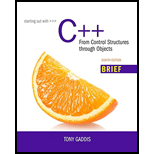
A retail store grants its customers a maximum amount of credit. Each customer’s available credit is his or her maximum amount of credit minus the amount of credit used. Write a pseudocode
After you write the pseudocode algorithm, convert it to a complete C++ program.
Trending nowThis is a popular solution!

Chapter 3 Solutions
Starting Out with C++: From Control Structures through Objects, Brief Version plus MyLab Programming with Pearson eText - Access Card Package (8th Edition)
Additional Engineering Textbook Solutions
Degarmo's Materials And Processes In Manufacturing
Thinking Like an Engineer: An Active Learning Approach (4th Edition)
Computer Science: An Overview (13th Edition) (What's New in Computer Science)
Mechanics of Materials (10th Edition)
Starting Out With Visual Basic (8th Edition)
Concepts Of Programming Languages
- EX:[AE00]=fa50h number of ones =1111 1010 0101 0000 Physical address=4AE00h=4000h*10h+AE00h Mov ax,4000 Mov ds,ax; DS=4000h mov ds,4000 X Mov ax,[AE00] ; ax=[ae00]=FA50h Mov cx,10; 16 bit in decimal Mov bl,0 *: Ror ax,1 Jnc ** Inc bl **:Dec cx Jnz * ;LSB⇒CF Cf=1 ; it jump when CF=0, will not jump when CF=1 HW1: rewrite the above example use another wayarrow_forwardEX2: Write a piece of assembly code that can count the number of ones in word stored at 4AE00harrow_forwardWrite a program that simulates a Magic 8 Ball, which is a fortune-telling toy that displays a random response to a yes or no question. In the student sample programs for this book, you will find a text file named 8_ball_responses.txt. The file contains 12 responses, such as “I don’t think so”, “Yes, of course!”, “I’m not sure”, and so forth. The program should read the responses from the file into a list. It should prompt the user to ask a question, then display one of the responses, randomly selected from the list. The program should repeat until the user is ready to quit. Contents of 8_ball_responses.txt: Yes, of course! Without a doubt, yes. You can count on it. For sure! Ask me later. I'm not sure. I can't tell you right now. I'll tell you after my nap. No way! I don't think so. Without a doubt, no. The answer is clearly NO. (You can access the Computer Science Portal at www.pearsonhighered.com/gaddis.)arrow_forward
 C++ for Engineers and ScientistsComputer ScienceISBN:9781133187844Author:Bronson, Gary J.Publisher:Course Technology Ptr
C++ for Engineers and ScientistsComputer ScienceISBN:9781133187844Author:Bronson, Gary J.Publisher:Course Technology Ptr Microsoft Visual C#Computer ScienceISBN:9781337102100Author:Joyce, Farrell.Publisher:Cengage Learning,Programming Logic & Design ComprehensiveComputer ScienceISBN:9781337669405Author:FARRELLPublisher:Cengage
Microsoft Visual C#Computer ScienceISBN:9781337102100Author:Joyce, Farrell.Publisher:Cengage Learning,Programming Logic & Design ComprehensiveComputer ScienceISBN:9781337669405Author:FARRELLPublisher:Cengage C++ Programming: From Problem Analysis to Program...Computer ScienceISBN:9781337102087Author:D. S. MalikPublisher:Cengage Learning
C++ Programming: From Problem Analysis to Program...Computer ScienceISBN:9781337102087Author:D. S. MalikPublisher:Cengage Learning Programming with Microsoft Visual Basic 2017Computer ScienceISBN:9781337102124Author:Diane ZakPublisher:Cengage Learning
Programming with Microsoft Visual Basic 2017Computer ScienceISBN:9781337102124Author:Diane ZakPublisher:Cengage Learning EBK JAVA PROGRAMMINGComputer ScienceISBN:9781337671385Author:FARRELLPublisher:CENGAGE LEARNING - CONSIGNMENT
EBK JAVA PROGRAMMINGComputer ScienceISBN:9781337671385Author:FARRELLPublisher:CENGAGE LEARNING - CONSIGNMENT





